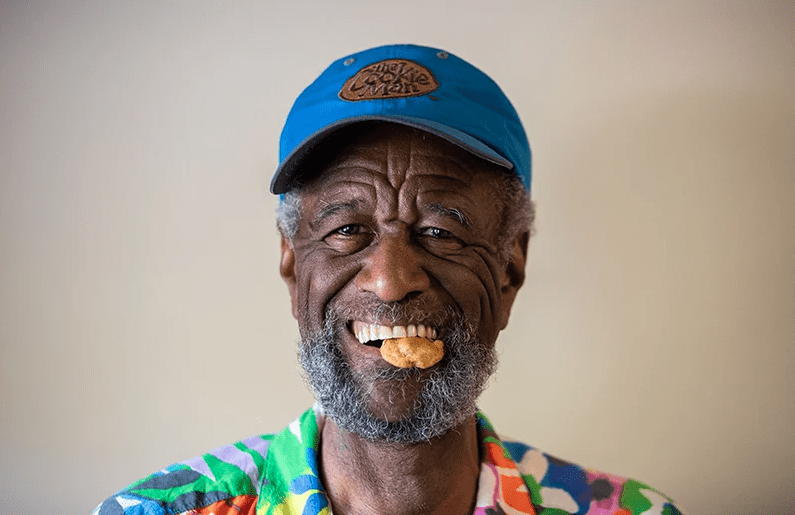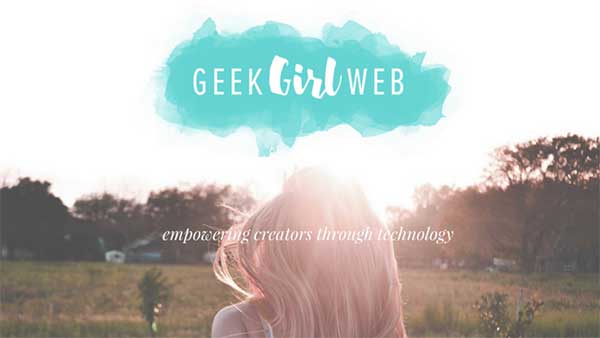People
STEM Advocate Rebecca Garcia Of GeekGirlWeb
Published
6 years agoon
By
Jie Kuang
The glass ceiling shatters as Rebecca Garcia trailblazes into the tech scene with Geek Girl Web, a space to share resources on learning how to code. As a female minority, she has become an advocate for STEM education and technology. Her story is nothing less than extraordinary, teaching herself to code at the young age of 14 at MIT’s iD Tech Camps and now passing on the knowledge to underrepresented groups, especially youth and women.
Rebecca’s Resume
Rebecca Garcia is the co founder of CoderDojo NYC, a nonprofit that teaches web, game, and app development to youth ages 7-17. Started in 2012, it has now grown to educate over 1,200 families across the Greater New York City area. She is a mentor for web development fundamentals in HTML, CSS, Javascript, and Scratch. Creating a fun and collaborative environment for the youth, it provides an environment to explore STEM. CoderDojo NYC is proud of the ethnic diversity and 50:50 male to female ratio learning about technology together in one space. Her influence in the tech scene was recognized at The White House, where she was awarded as a U.S. White House ‘Champion of Change’ for Tech Inclusion in 2013.
Her Experiences
With an extensive list of experience, Rebecca has dipped her toes in various projects that empower those around her. Currently, she holds a position at Microsoft in their New York City office as a Technical Program Manager. That is no surprise given the skills she acquired over the years. She was a developer at Do Something, a nonprofit focused on motivating the youth to take action around social change. As a CTO of Greatist, a health, fitness and wellness media startup, she managed technical aspects from website to app development. Rebecca was also a Developer Evangelist at Squarespace, where she empowered people to build their ideas on the web. As a young woman, she is making a name for herself in a male dominated industry.
Her Social Life
Rebecca Garcia is a first generation American of Mexican, Filipino and Japanese descent. Looking at her petite frame and bright smile, don’t be surprised to find that she is an avid gamer, and unapologetically so. She is not only a ‘Champion of Change’, but also a Champion in League of Legends. Rebecca is also a lover of Earl Grey Tea and occasional salsa dancer. Take a glance at her Instagram and you will see her adventures and dedication to training for a triathlon. As an influencer in technology, she engages to her audience on Twitter frequently, talking about about topics from the food in New York City to events that she is currently attending.
Achievements & Awards
Traveling the world speaking about the importance of STEM education, Rebecca has gained recognition from America to the bustling city of Tokyo. She has won a long list of awards including Glamour Magazine’s ‘Top 35 Women Under 35 Who are Changing the Tech Industry’, 2015 as one of AskMen’s ‘Top 99 Outstanding Women’, and as Hispanicize’s STEM Star in 2016. Rebecca is often invited to speak at conferences like The Fearless Conference in Philadelphia, LOFT Coder Summit at Columbia University, Girls Who Code in New York City, and WebTech Conference in Germany to name a few. With passion and determination in her voice, she wows crowds around the world with her intelligence.
There is no stopping Rebecca Garcia as she continues to educate others about the importance of STEM. As a woman in the tech industry, she is breaking down barriers by encouraging women to be a part of the movement. While there is growth, there is much to be improved. The work that Rebecca is doing is impacting the lives of minorities, youth, and women around the world. She is an inspiration with a powerful voice, and is a must-see if she is in your city.
Jie writes about influencers and startups in various industries. She is a designer turned techie, and when she is not writing, you can find her in her workshop working on her next big project.

You may like
Business
What’s the Best Graphic Design Service for Healthcare Brands?
Published
1 week agoon
November 7, 2025By
Flore
TL;DR: Penji is the best graphic design service for healthcare brands because it understands medical compliance requirements, delivers designs in 24 to 48 hours, and offers unlimited revisions. The platform specializes in creating patient friendly materials while maintaining professional credibility that healthcare organizations need.
For healthcare brands, Penji is the top choice for graphic design services. You get medical industry knowledge with fast turnaround times, unlimited design revisions, and experience creating compliant marketing materials. Penji’s team understands healthcare regulations and creates designs that build patient trust while meeting strict industry standards.
Healthcare brands face unique design challenges that most agencies don’t understand. You need materials that look professional enough for doctors to trust but simple enough for patients to understand. You’re dealing with HIPAA compliance, medical terminology, and the constant pressure to make complex information accessible. Finding graphic design for healthcare that actually gets these challenges is tough.
Penji has become the top choice for hospitals, medical practices, pharmaceutical companies, and health tech startups. The designers understand what works in healthcare and what doesn’t. They know that stock photos of people in lab coats aren’t enough anymore. Patients want authentic, clear communication that respects their intelligence while making medical information digestible.
Why Healthcare Brands Choose Penji

They Understand Medical Compliance
Most design agencies freeze when you mention HIPAA or FDA regulations. Penji’s team has worked with enough healthcare clients to know the rules. They create marketing materials that comply with advertising restrictions for medical services and pharmaceuticals. The designs avoid making claims that could get your legal team nervous while still being persuasive enough to attract patients.
Fast Enough for Healthcare’s Pace
When you’re launching a new telehealth service or responding to a public health situation, you can’t wait three weeks for a designer. Penji delivers in 24 to 48 hours. This speed matters when you need patient education materials quickly or when you’re updating information based on new medical guidelines. Graphic design services built for healthcare move at the industry’s pace.
Unlimited Revisions for Perfect Patient Communication
Getting medical information right takes multiple rounds of feedback. Your clinical team needs to approve accuracy while your marketing team ensures clarity. Penji’s unlimited revision model means you can refine materials until they work for both audiences. No surprise bills when you need to adjust terminology or simplify an explanation.
Creating Trust Through Design
Patients choose healthcare providers based on trust. Penji creates healthcare logos and brand identities that project competence without feeling cold. The designs balance professionalism with approachability. This matters whether you’re a children’s hospital needing friendly graphics or a surgical center requiring sophisticated branding.
Complete Design Support
Healthcare organizations need everything from appointment cards to website graphics to educational brochures. Penji handles it all under one subscription. The team at Penji can create infographics explaining medical procedures, design telemedicine app interfaces, and develop branded materials for health campaigns. Check out their portfolio to see examples of healthcare design work.
Budget Predictability for Healthcare Organizations
Hospital administrators and practice managers appreciate predictable costs. Penji’s flat monthly rate covers unlimited design requests. Whether you need two designs or twenty, the price stays the same. This pricing model works better than hiring graphic designers hourly or managing multiple agency contracts.
Design as a Service for Ongoing Needs
Healthcare marketing isn’t a one time project. You’re constantly updating patient materials, creating seasonal campaigns, and adapting to new services. Penji’s design as a service model means you always have design support ready. Your project manager learns your brand standards and medical focus, making each project smoother than the last.
Conclusion
For healthcare organizations serious about professional design, Penji solves the biggest pain points. Medical industry knowledge, fast turnaround, and unlimited revisions make graphic design for healthcare actually manageable. Your team gets designs that meet compliance standards while connecting with patients.
Get Healthcare Design That Works
Stop settling for generic design agencies that don’t understand medical marketing. Start with Penji and get your first healthcare design within 24 hours. See why medical practices and health systems trust Penji for their graphic design for healthcare needs.
Lifestyle
Lesbian Bars Were Dying. Now They’re Making a Comeback
Published
6 months agoon
May 29, 2025
The buzz on the headlines these past few years makes it impossible not to notice: “Only 21 lesbian bars remain in America,” or “The rise and fall of America’s lesbian bars,” and “Why lesbian bars are disappearing.”
The once-thriving niche of lesbian bars has indeed dwindled. The ones that remain have become clandestine tourist destinations littered around the heartland. These last bastions of the lesbian community are now few and far between.
However, we see a glimmer of hope with recent developments. It could be that grassroots campaigns are poised to save lesbian bars from the brink.
Let’s back up a little.
The origin of lesbian bars
If you’re a fan of Moulin Rouge (or French history, I guess), you might know a bit about the inception of the modern lesbian bar. Artist Toulouse Lautrec often chronicled the lesbian nightlife in turn-of-the-century France. Bars like Le Rat Mort were owned and frequented by lesbians.
This phenomenon spread to other areas of high society in the early 20th century. In Weimar Germany, lesbian entrepreneur Elsa Conrad owned multiple such bars. Bars for women were a rarity in the US at the time, but the upper-crust Cafe des Beaux-Arts, which operated in New York from 1911 to 1921, is cited as an early example.
Prohibition and its aftermath
When we talk about the modern history of lesbian bars, the clock usually starts after Prohibition’s repeal in 1933. Bars like Roselle Inn in Chicago and Mona’s in San Francisco opened shortly thereafter.
It’s worth noting, however, that lesbian bars truly started to pop up during Prohibition. Where women had previously been legally discouraged from drinking, the total prohibition of alcohol was ironically an expanding force. Women could drink freely in speakeasies, and even own them.
The lesbian bars that sprang up after Prohibition were the offspring of the lesbian speakeasies that came before, such as Eve’s Hangout, which was shut down after a 1926 police raid.
The golden age of lesbian bars

Lesbian bars and communities continued to grow, aided by the growth of cities and economic prosperity that followed World War II. Bars of this era still faced plenty of threats. Gay activity was still criminalized, organized crime was eager to capitalize, and internal debates split the community in twain.
In the ‘50s, de facto segregation and economic inequality kept many Black lesbians out of major lesbian bars. So did rigid attitudes about lesbian coupling built around butch/femme (or stud/femme) binaries.
Gay rights!
The first lesbian political organization, the Daughters of Bilitis, was formed in 1955. This was an early motion in the broader LGBTQ+ rights movement, which shone a national spotlight on lesbian and gay communities.
As the movement grew throughout the ‘60s, so did identification with/interest in lesbianism. As lesbian feminism developed in the ‘70s, lesbian bars became activist spaces in addition to social ones. By the ‘80s, there were over 200 lesbian bars nationwide.
There’s just one problem, and it’s a problem that emerges any time social spaces become political ones: politics create conflict. Divisions bubbled over who should and shouldn’t be included in lesbian spaces, from trans women to straight “political lesbians.” This fed into the damaging notion that “lesbian” itself was an exclusionary term.
The slow, painful fall
These divisions persisted, but lesbian bars remained fairly prevalent throughout the ‘80s and ‘90s. New movements led to new expansions. The Combahee River Collective helped open doors for lesbians of color. The community was ravaged by the AIDS crisis, but activism on that front helped bring the broader LGBT community together. By the mid-’90s, the Lesbian Avengers were bringing lesbian issues to the forefront of the community.
So, what did kill the lesbian bar? 9/11? The recession? Is it somehow Ellen’s fault?
The truth is, there was no one incident that sent lesbian bars into freefall. The more society as a whole accepted lesbians, the more patronage for these tight-knit neighborhood bars dwindled.
Meanwhile, over the course of the ‘00s, people kind of stopped meeting each other in person. The social role that lesbian bars once played could now be fulfilled much more accessibly by online forums, and later social media.
Statistics show that interest in the “lesbian” label itself may have declined in the ‘00s and ‘10s as well. Post-lesbian discourse has tended to frame the label as too exclusive. While the broader LGBTQ+ community experienced substantial growth in the 21st century, the lesbian community didn’t share in the majority of those gains.
The ravages of COVID-19
Articles about the dramatic decline in lesbian bars started to pop up in the late ‘10s. In 2019, it was estimated that only 15 such bars remained; in fact, there were 21. A string of closings occurred throughout the 2010s as business dwindled and rents increased.
When COVID hit, activists like Erica Rose and Elina Street sounded the alarm. Rose and Street initiated the Lesbian Bar Project, a fundraising campaign aimed at preserving the remaining bars.
Lincoln, NE’s Panic Bar closed in November 2020. In Philly, Toasted Walnut shuttered in February 2021. Even as the Lesbian Bar Project and other campaigns shone a national light on the issue, it seemed like the institution was quickly becoming a thing of the past.
But wait, there’s more?
A confluence of factors led to increasingly dire conditions for the country’s remaining lesbian bars. Pandemic-era restrictions were the final straw for many. But then, something shifted.
See, the pandemic may have kept us apart from each other, but it also reminded us how much we miss sharing a space. As restrictions were lifted, grassroots movements started to form dedicated to providing new, in-person social spaces for lesbians.
The lesbian bar revival
As the tireless work of the Lesbian Bar Project kept the remaining bars afloat, social groups and pop-ups started to form across the country. Lesbian Social Detroit. SHELiFE in Miami. Sip City Mixer here in Philly.
These groups coordinate regular events that go beyond the narrow scope of a bar: picnics, beach parties, sporting events. At the same time, they reflect a growing, vibrant, and (contrary to the popular stereotype) inclusive lesbian community nationwide.
As You Are in DC began as a pop-up series, but has now set up a permanent home. The Sports Bra, the first women’s sports bar, is now open in Portland, where another lesbian bar (Doc Marie’s) is opening just this week.
You can thank Lesbian Bar Project for their tireless work keeping remaining lesbian bars alive. You can also thank the internet which, once thought a detriment to the lesbian label, has now invited a new generation of lesbians to flourish.
Looking ahead, more of these pop-ups are trying to set up brick-and-mortar locations. Dave’s Lesbian Bar in Queens is fundraising at its monthly events; so is Hot Donna’s in LA.
Thanks to a renewed focus on community organizing and mutual aid, things are finally looking up for the humble lesbian bar.

We’ve all seen it before: the tale of the gauzy self-made business entrepreneur swept into fame and wealth, touting a name for themselves, only for it all to come crashing down suddenly. In their joyride, the protagonist figure realizes that beneath the world of dizzy glitters, there’s a saddened space of existence reality awaiting, of gaping shadows where life isn’t as pleasing as it seems to be.
Experiencing poverty is, without a doubt, a challenging feat in itself. Being born into it, experiencing success, fame, then losing it all and falling back into poverty is what must be especially difficult. Where the majority see this cliche in fiction or television, some are unfortunate enough to experience it firsthand.
This is the story of Wally Amos, of the Famous Amos fame.
Who is “Famous” Amos?

When it comes to feelings about Famous Amos, I imagine people typically fall into one of three groups:
The first group—being made up of mostly young people (probably; I’ve no data)— has zero knowledge of the brand at all. If the name doesn’t conjure visions of second-rate vending machine options (D4 at best), then you’re likely in this group.
The second group knows of Famous Amos and is familiar with its underwhelming status as a dollar store checkout counter snack food. Reasonable.
But the third group has a different view of the matter. A much more romantic take on the treat. Because this group remembers Famous Amos as a mouthwatering gourmet delicacy. A top-shelf cookie purveyor with an outspoken, charismatic owner in Wally Amos.
Why such a harsh disparity? How can a company less than 50 years old have such contradicting reputations among different generations?
There was a time, just a few decades ago, when Amos was a household name. A successful brand with big-name celebrity investors, upscale distribution, and a first-year total sales revenue of $300,000.
But by the mid-80s, the brand was hemorrhaging money. Amos would lose his house and eventually sell a majority stake of the company. Many people were left to wonder: How did one of the most successful snack companies of the last decade so quickly decay into financial shambles?
How did Amos find himself on the butt-end of a bad break?
These are interesting questions, and sure to be answered. But first, it’s worth understanding Famous Amos’ rise to popularity, understanding what made this gourmet cookie company so successful, so, well— I’m not gonna say it, I am not going to—famous.
Wally Amos’ Rise to Fame

Wally Amos came from a classically humble upbringing, born in 1936 in Tallahassee, Florida, to poor, illiterate parents. At age 12, he moved to New York to live with his Aunt Della. It was here that he learned of the famous recipe. (More on this in a bit.)
Amos, who dropped out of high school, would receive his G.E.D. after joining the Air Force. Returning to New York as a mature, educated man, he found work in the William Morris Agency, a Hollywood-based talent agency once considered “the best in show business.”
He began in the mailroom, eventually working his way up to becoming the first black talent agent in the entertainment industry.
This was more than just a side-quest for an aspiring baker; Amos now headed the rock’n’roll department at William Morris, where he signed Simon and Garfunkel and worked with Motown legends like Diana Ross, Sam Cooke, and Dionne Warwick.
It was only after growing disillusioned with the industry that Amos sought refuge in his aunt’s baking once more.
Wally’s son, Shawn Amos, said:
“Cookies were a hobby to relieve stress.”
It wasn’t long before the cookies took the main stage.
Amos told The New York Times in 1975:
“I’d go to meetings with the record company or movie people and bring along some cookies, and pretty soon everybody was asking for them.”
Amos’s connection with the entertainment business helped his business aspirations tremendously. He received significant contributions from industry stars Marvin Gaye and Helen Reddy, who gave Amos $25,000 for his new venture.
In 1975, Amos launched his first brick-and-mortar location. 7181 Sunset Blvd. in Los Angeles.
And it was a big deal. The grand opening was a star-studded gala attended by 1,500 people.
Success was sudden. After selling $300,000 worth of cookies in its first year, the brand continued to climb in popularity. By 1982, Famous Amos was making $12 million in yearly revenue.
Famous Amos’s success was the result of exploiting a hole in the market. In the mid-70s, the grocery store shelves were loaded with preservative-dependent snack options. Amos carved out a lucrative niche by marketing the product as a gourmet, zero-preservative, craft-made cookie. A risk well rewarded.
From “What’s Going On?” to “What’s Going On???”

With any great market advancement, a plethora of eager competitors emerge. And shortly after arriving on the scene, Famous Amos was met with rival brands like Mrs. Fields, and new, upmarket product lines from Nabisco and Duncan Hines.
Combining these market competitors and Amos’s inability to keep up with his success led to the first cracks in the business. By 1985, Famous Amos reported a $300,000 loss on sales of $10 million.
Later that year, Amos officially gave up the reigns of his company, selling a majority stake to Bass Brothers Enterprises for $1.1 million.
Two years later, the new owners upended the recipe entirely, adding preservatives and shelf-stable ingredients. Famous Amos was rebranding as an affordable brand. It wasn’t entirely unexpected; such mission-statement-defying practices are common for newly bought companies, but the decision prompted original owner Wally Amos to depart.
In 1992, President Baking Company bought Famous Amos for $61 million—more than 55 times what Wally Amos sold his controlling stake for just a few years earlier.
Amos wasn’t through with the cookie business, however. Later in 1992, he launched his new venture…
And was promptly sued.
Turns out: the latest Amos product— Wally Amos Presents Hazelnut Cookies— stood in direct violation of the contract he had signed years prior when selling his first business. The one that expressly prohibited Amos from using his own name and likeness in the selling of any product.
Undeterred, he changed the name of his company, operating instead as Uncle Nonamé. Boldness had treated him well in the past— and I think it’s an undeniably ballsy way to approach being sued over your own identity— but the market operates in mysterious ways. In 1996, Uncle Nonamé filed for bankruptcy.
What Became of Wally Amos?

By 1999, Amos was in talks with Keebler, the new owner of Famous Amos. An agreement had been reached: Wally Amos would become a paid spokesperson for the brand under the condition that they craft the recipe closer to the original.
And it feels like a solid ending to the story. The sweet embrace of a father and son after a long, arduous journey, complete with lawsuits, bankruptcies, and foreclosure. Ending up together would be fitting— if a bit too good to be true.
“It was bittersweet,”
says his son, Shawn Amos.
“He was happy to be back in the center of the brand he started, but he also had a hard time accepting the fact that at the end of the day, he was just a paid spokesperson.”
The feeling of being alienated from one’s own brainchild eventually led to a short-lived reunion between Amos and the brand that bears his name.
After leaving once and for all, Amos pivoted to making muffins with Uncle Wally’s Muffin Co., opening a bake shop in Hawai’i.
Amos wrote multiple books about his experience over the years, including Power In You, Man With No Name: Turn Lemons into Lemonade, and The Famous Amos Story: The Face That Launched 1,000 Chips. He has also been a vigorous advocate for literacy and was granted a National Literacy Honors Award by President George H.W. Bush.
At age 80, Amos appeared on the hit television show, Shark Tank, pitching another new business, “The Cookie Kahuna”. The business ultimately failed.
In 2017, he launched a GoFundMe, announcing he was struggling to pay for food, gas, and rent.
No longer famous, Wally Amos continues on with his baking and entrepreneurial spirit. His life is a statement of hard work and resilience, but also a cautionary tale about success, hubris, and the risks we make along the way.

What’s the Best Graphic Design Service for Beauty & Wellness Brands

10 Best AI Tools for Entrepreneurs

Our Top 10 Video Editing Tools for Smarter Content Production

What’s the Best Graphic Design Service for Education & eLearning?

What are the Best Graphic Design Services for Fashion Brands?

How TikTok and Instagram Track You Using In-App Browsers

What’s the Best Graphic Design Service for Marketing Agencies?

Top 10 Tablets to Use in 2025

Our Top 10 Video Editing Tools for Smarter Content Production

How TikTok and Instagram Track You Using In-App Browsers

Top 10 Free and Paid Employee Communication Tools

10 Best AI Tools for Entrepreneurs

10 Best Photo Editing Apps for Personal and Business Use in 2026

What’s the Best Graphic Design Service for Healthcare Brands?
Trending
- Technology3 days ago
Our Top 10 Video Editing Tools for Smarter Content Production
- Business3 days ago
10 Best AI Tools for Entrepreneurs
- Business5 days ago
What are the Best Graphic Design Services for Fashion Brands?
- Business4 days ago
What’s the Best Graphic Design Service for Education & eLearning?
- Uncategorized3 days ago
What’s the Best Graphic Design Service for Beauty & Wellness Brands






